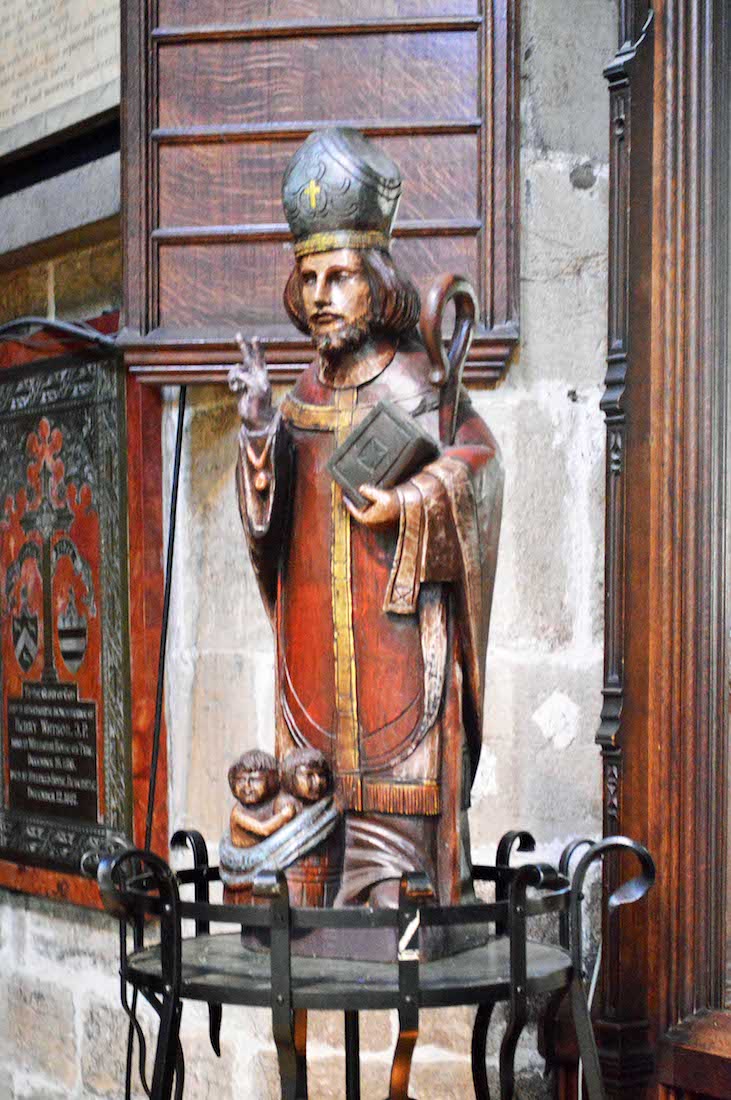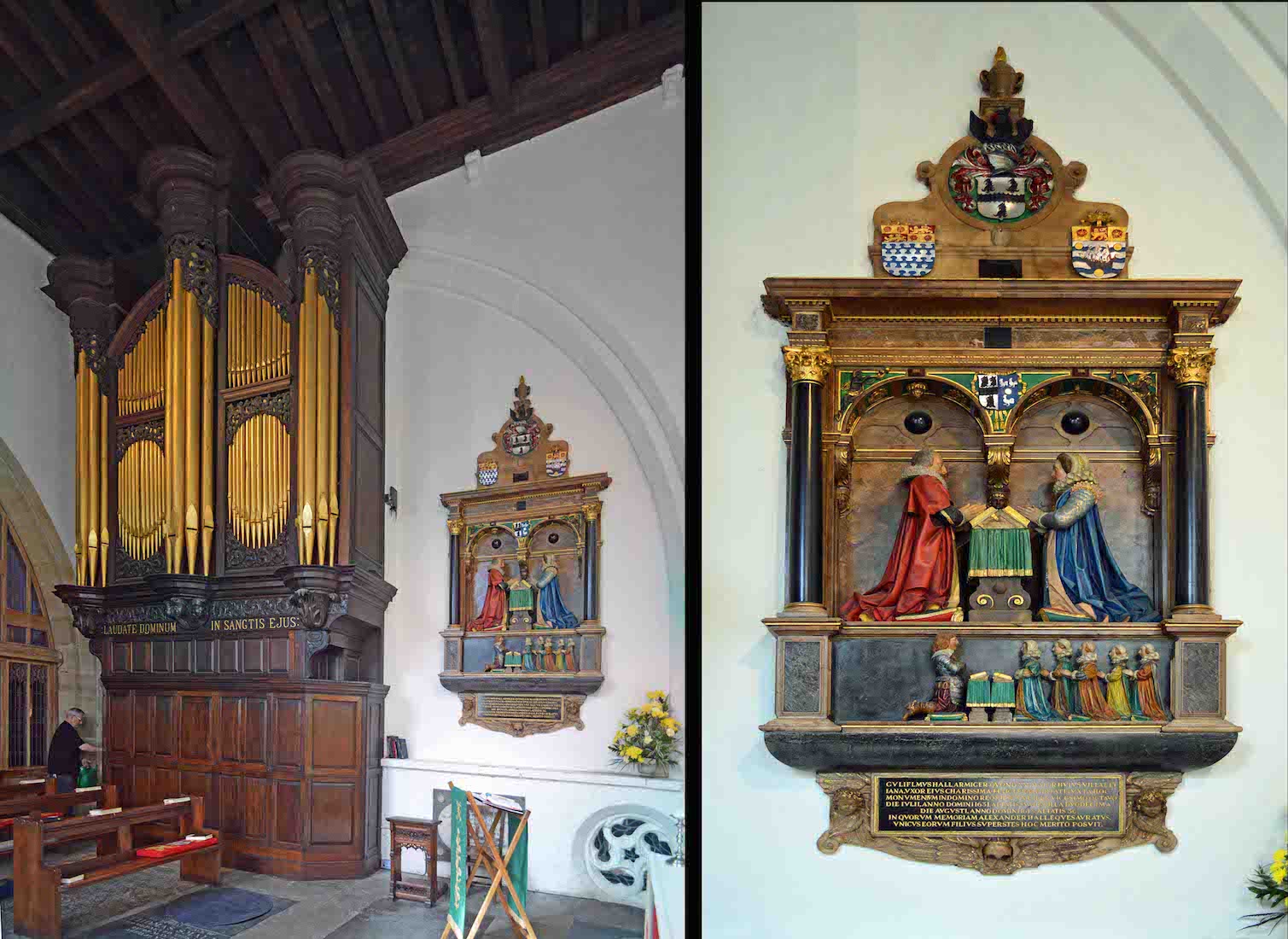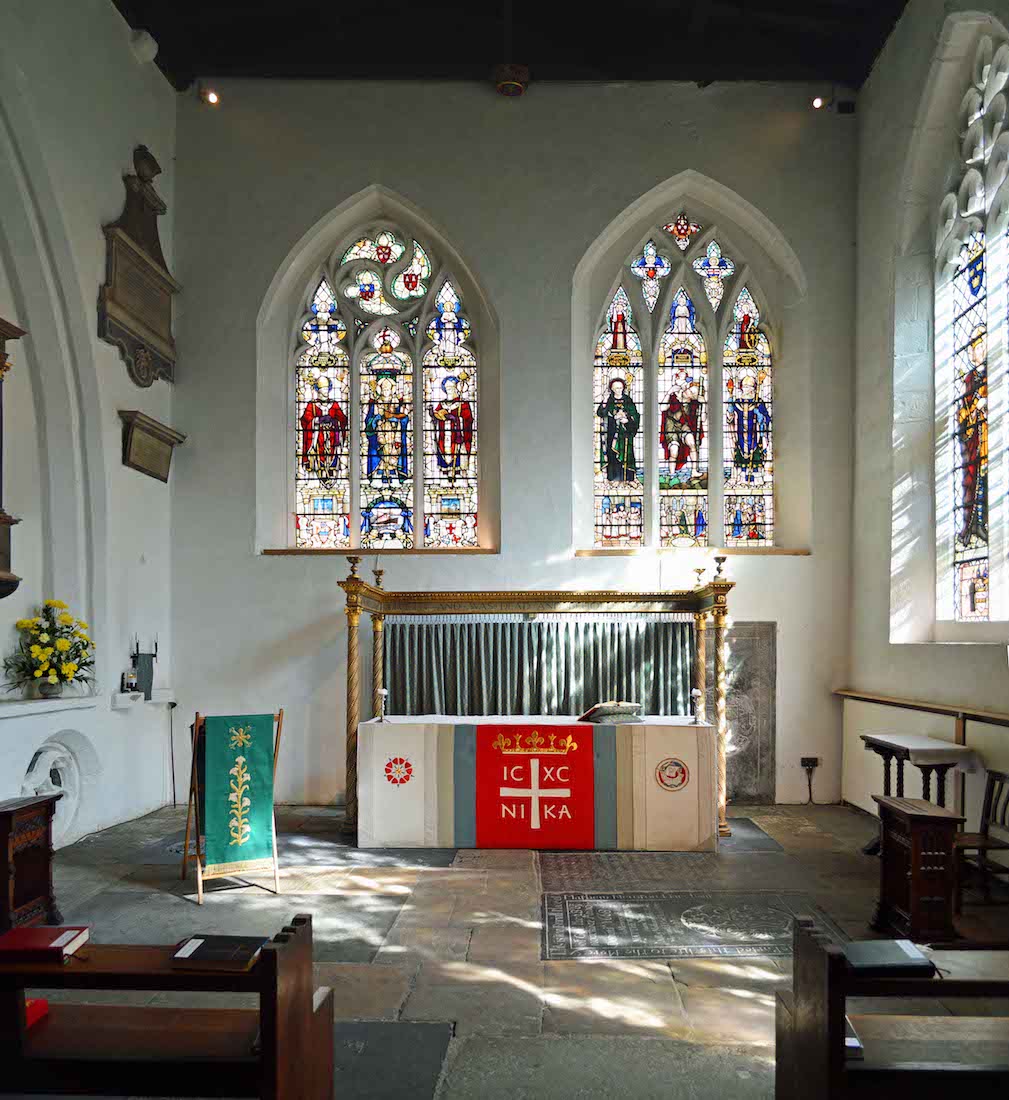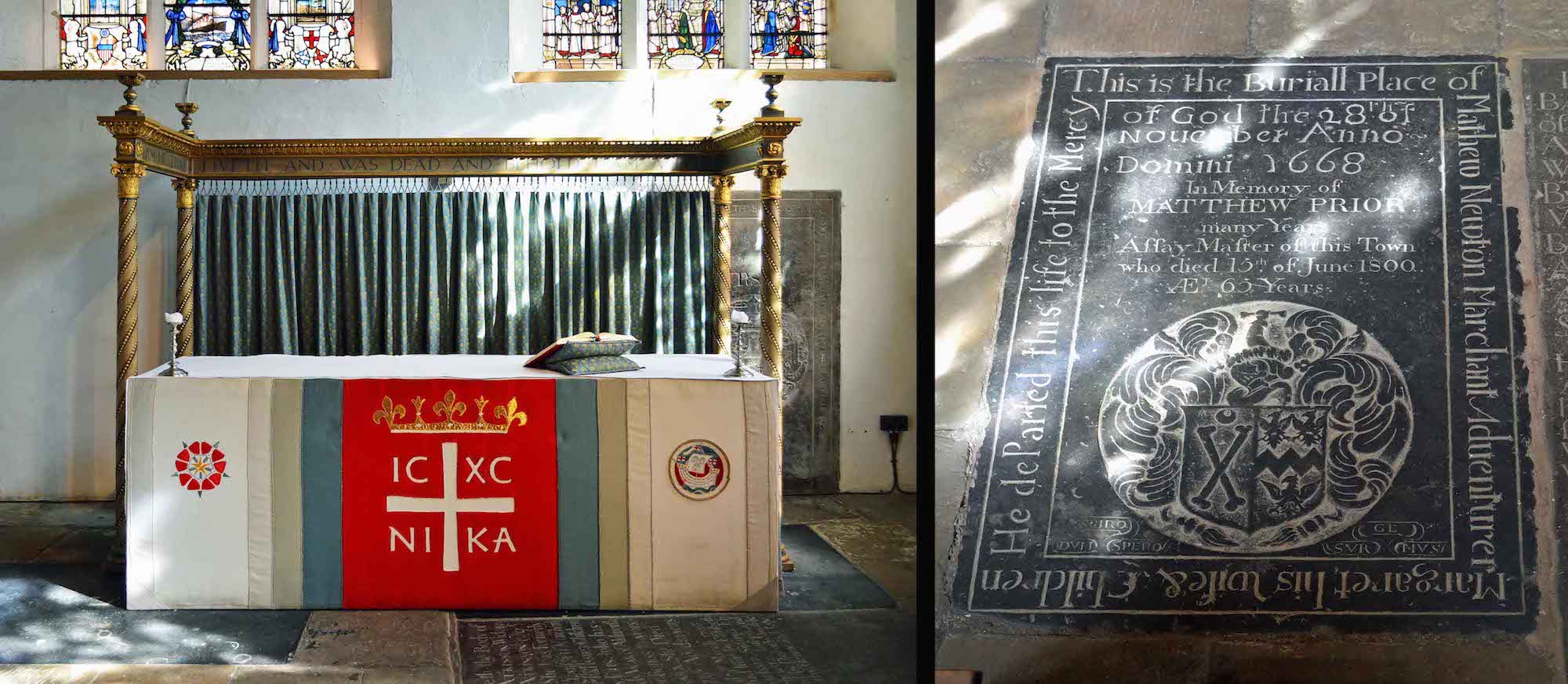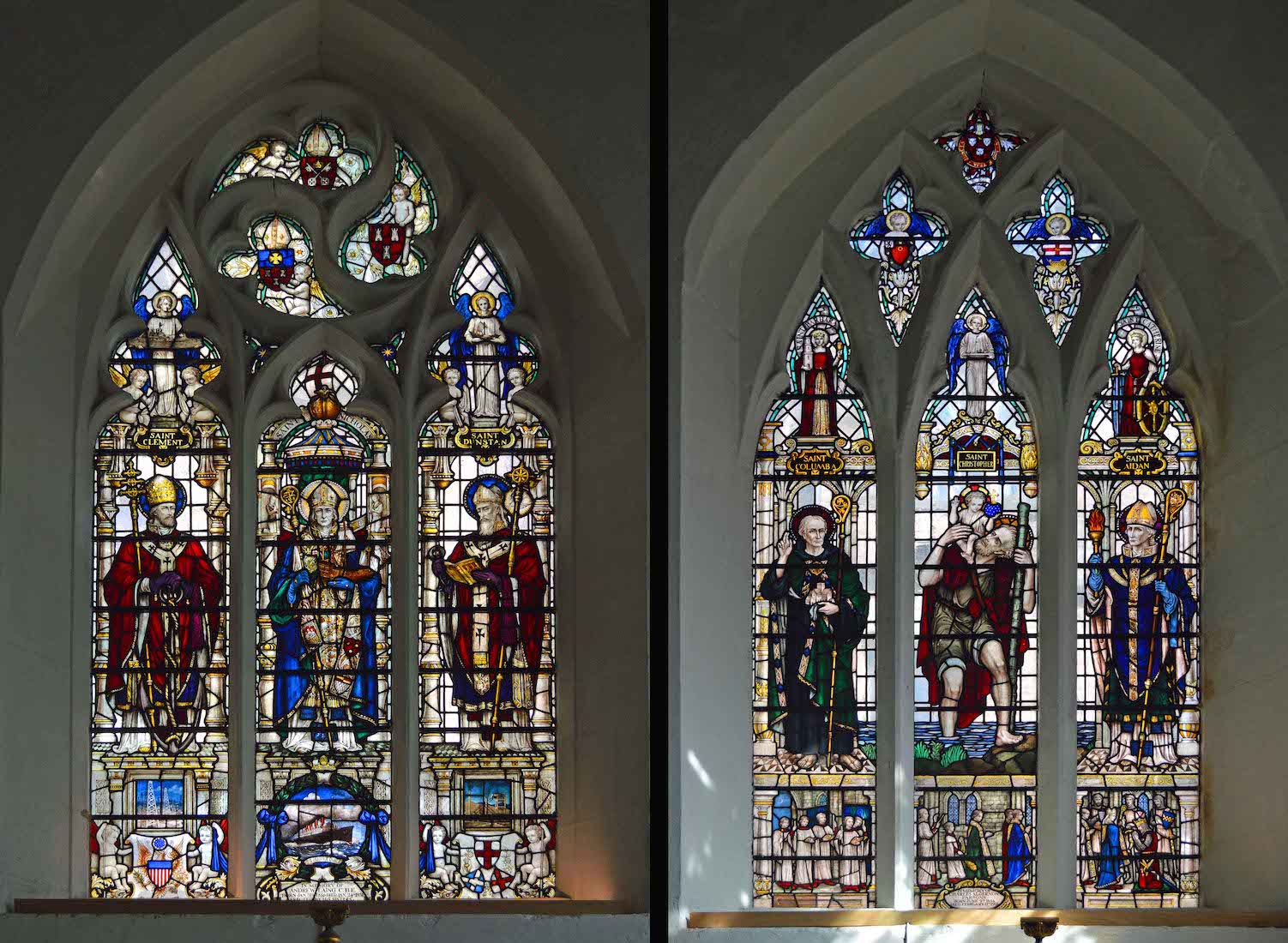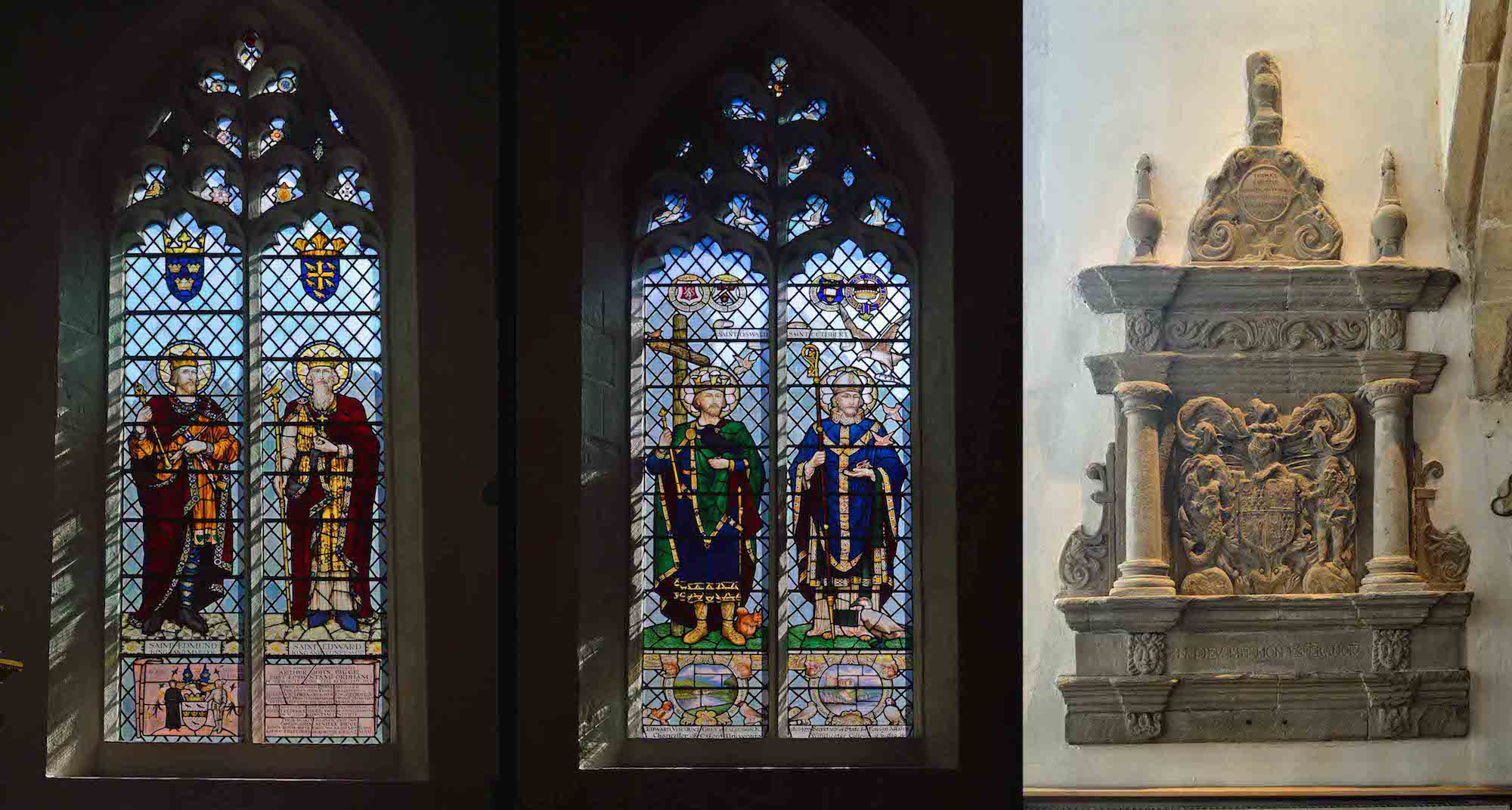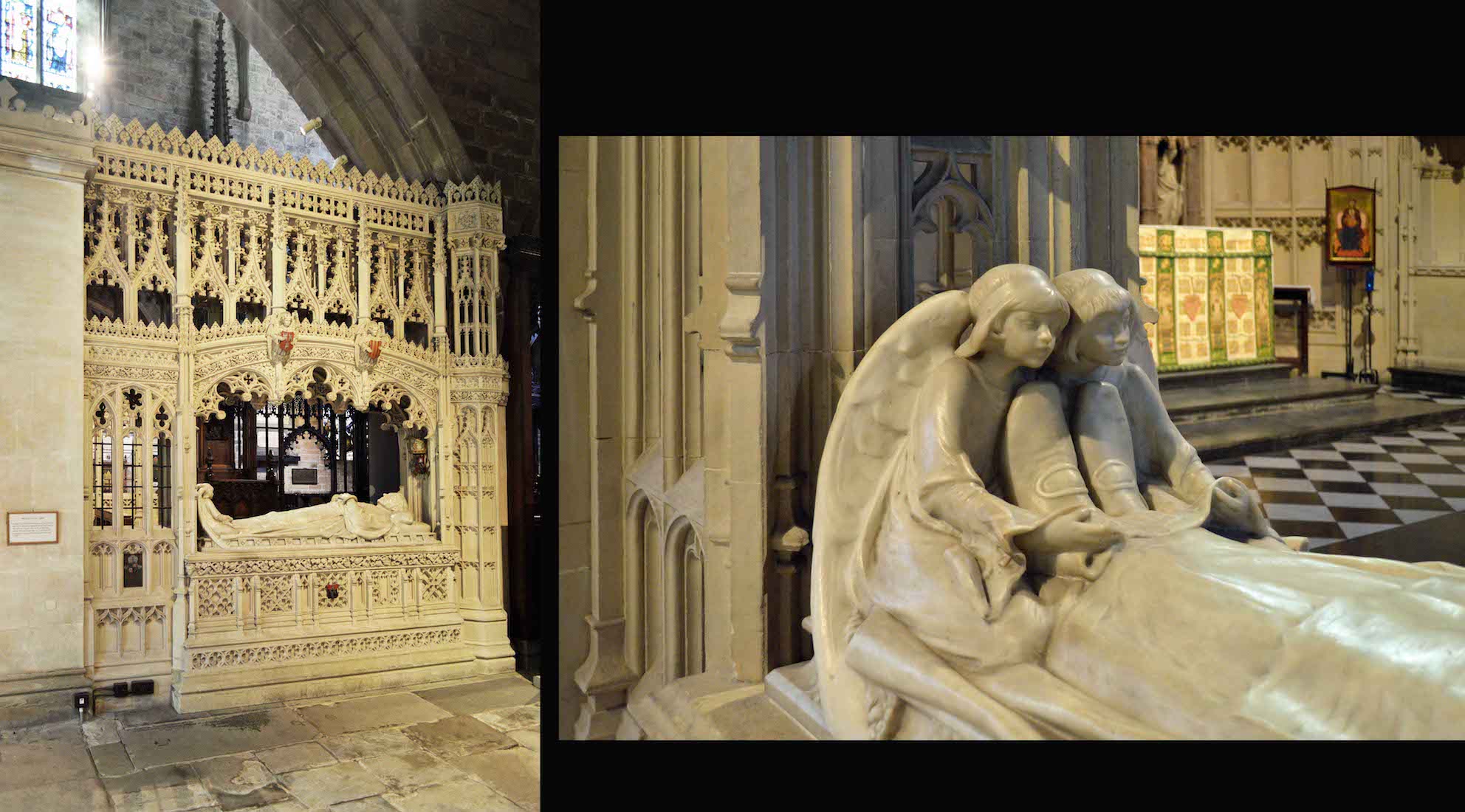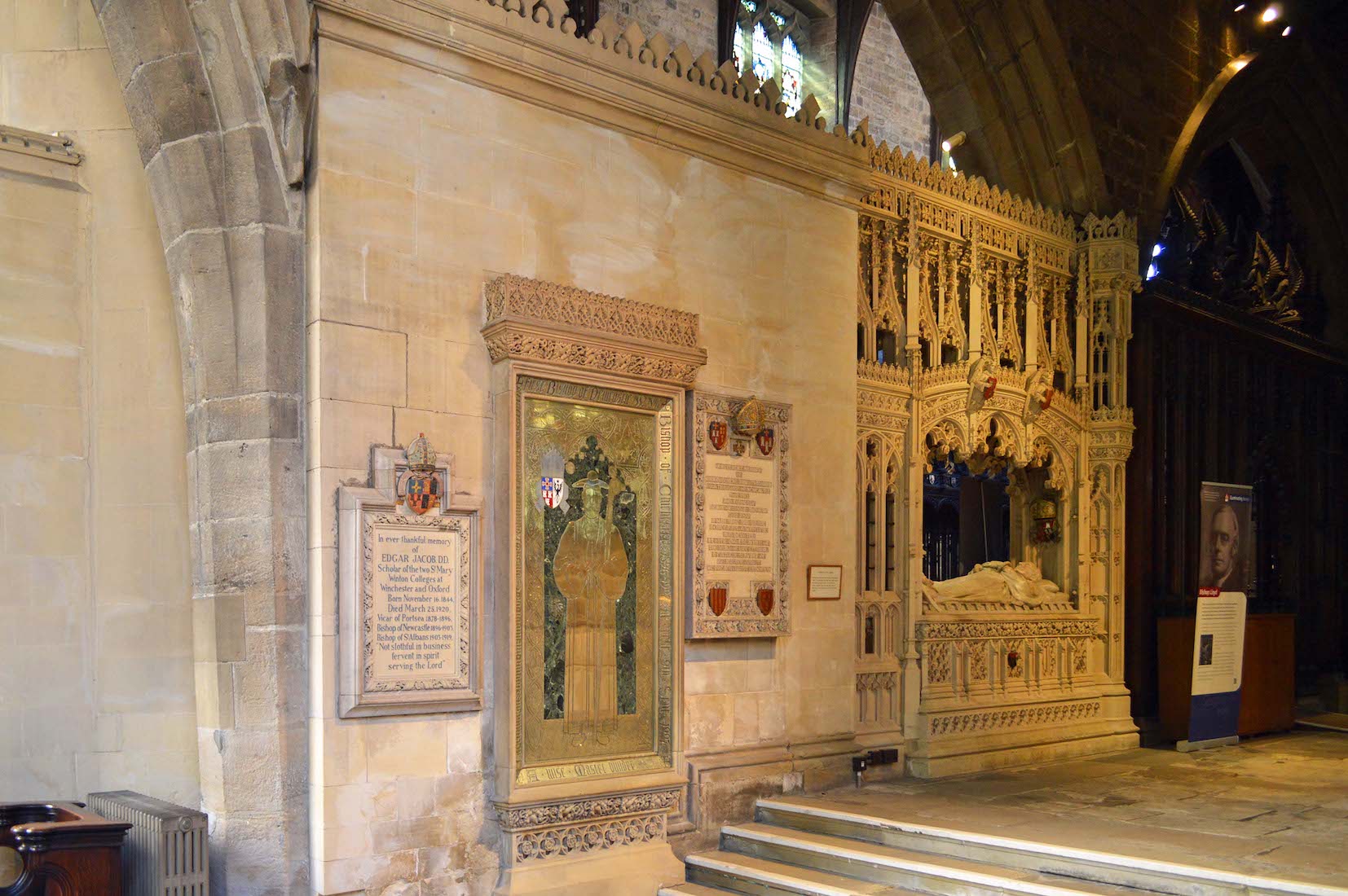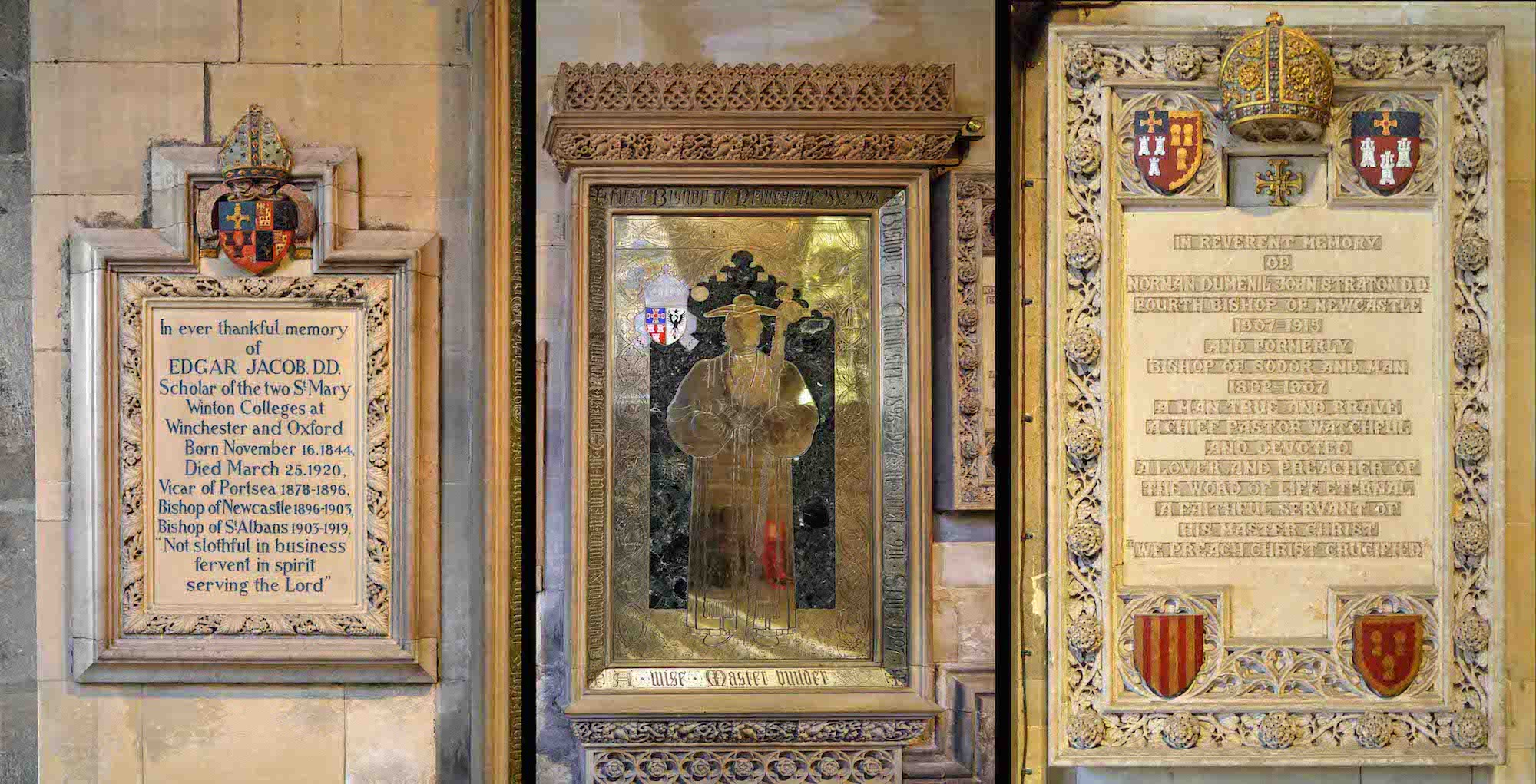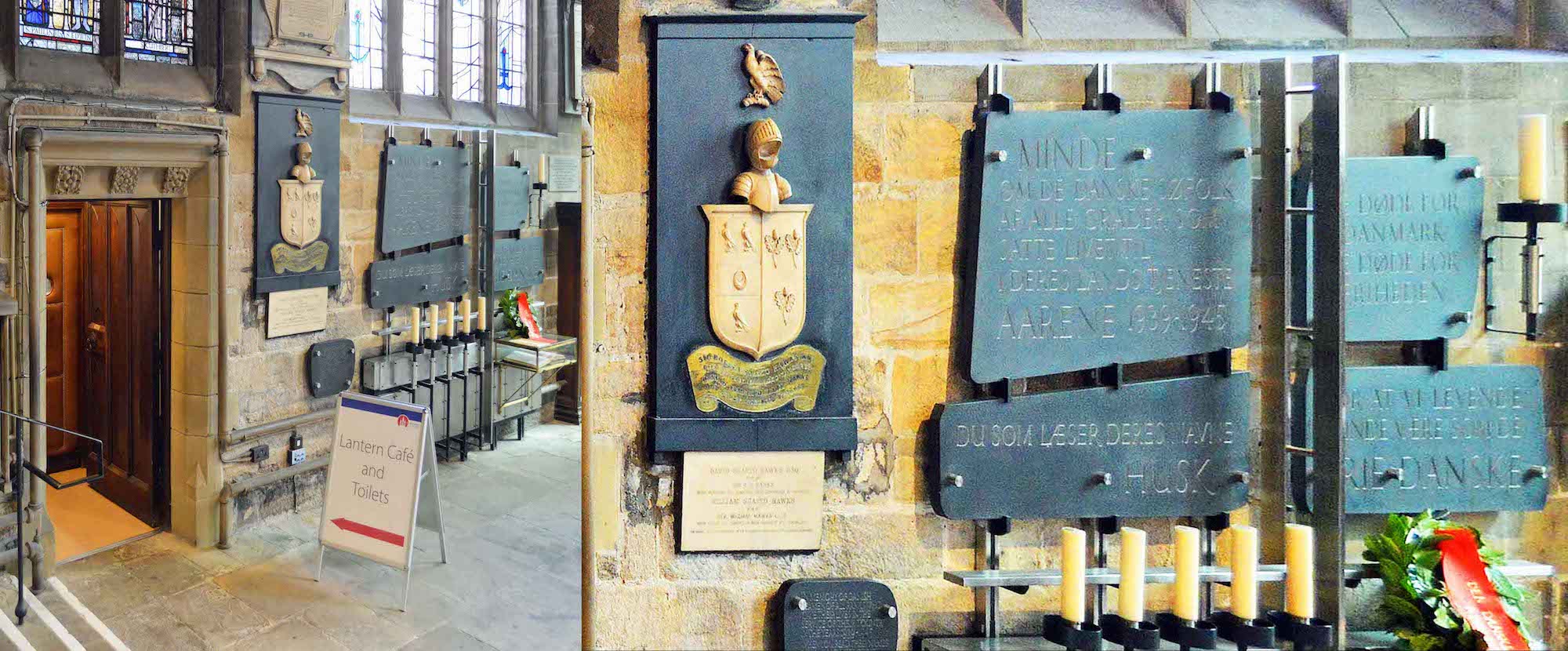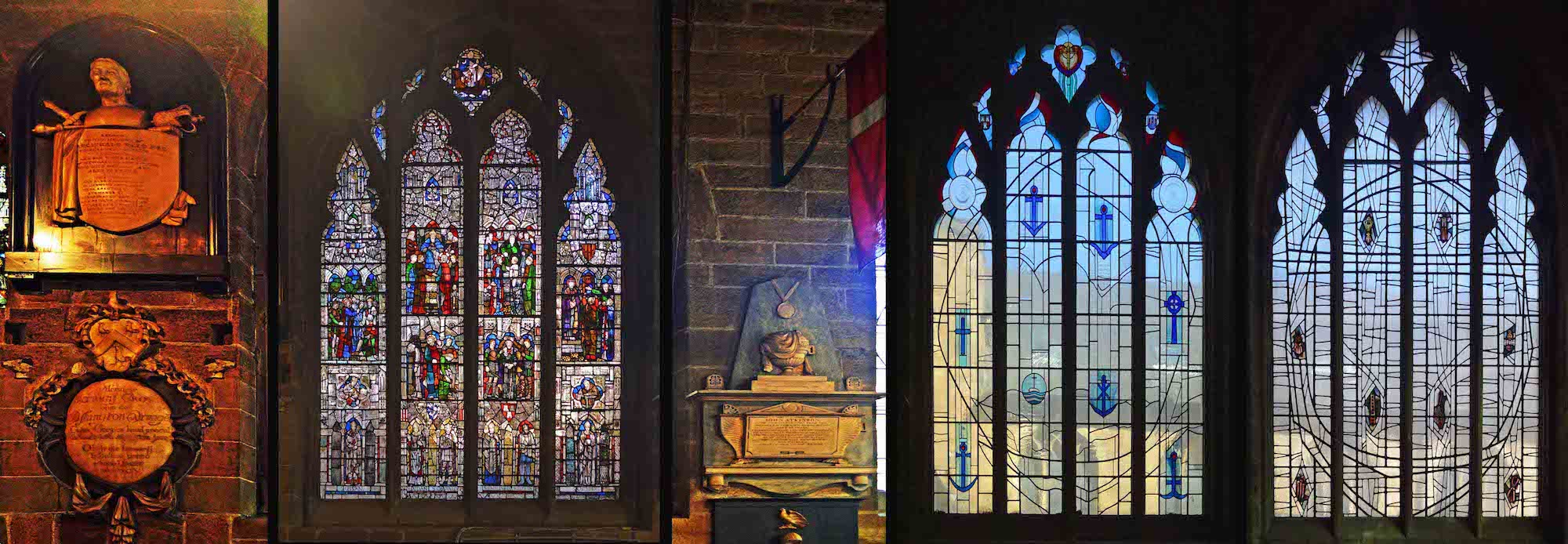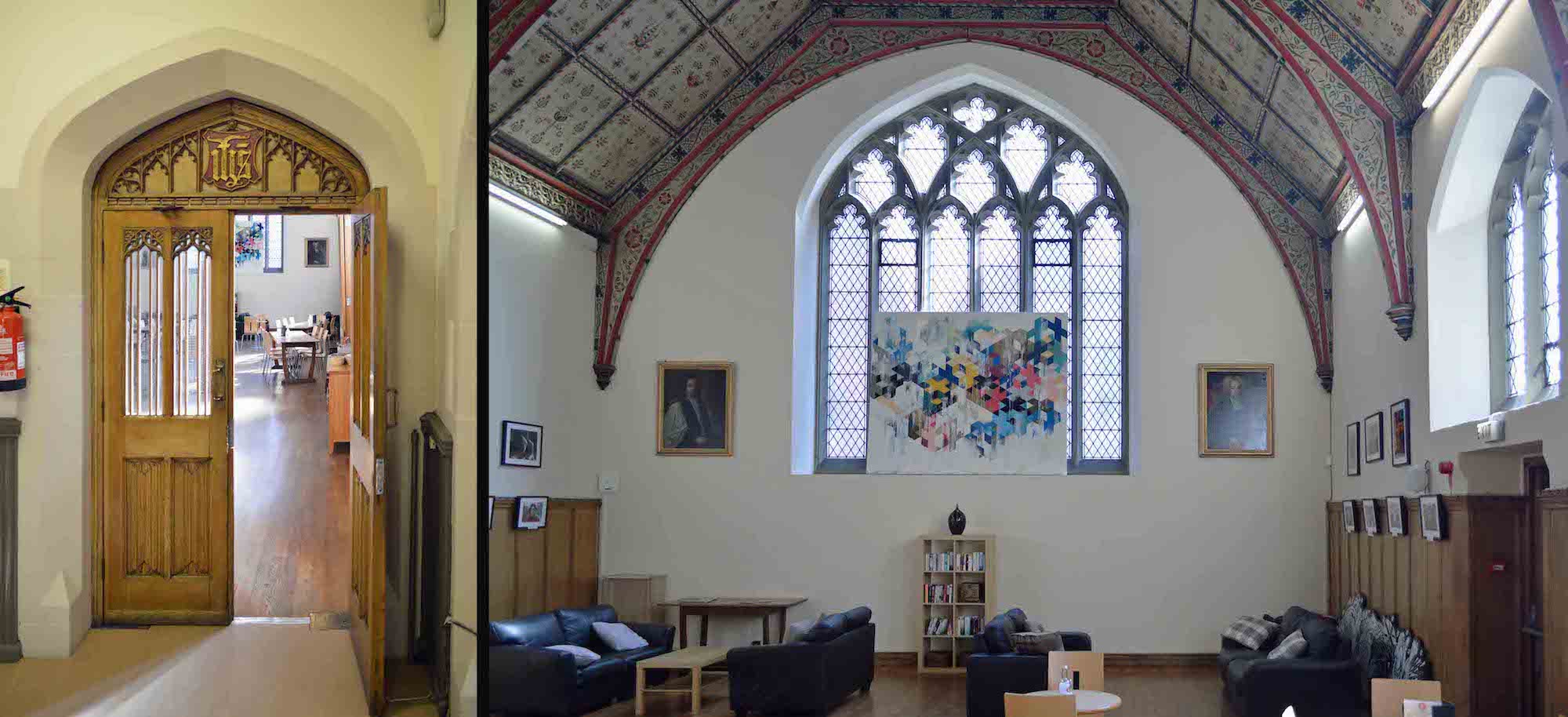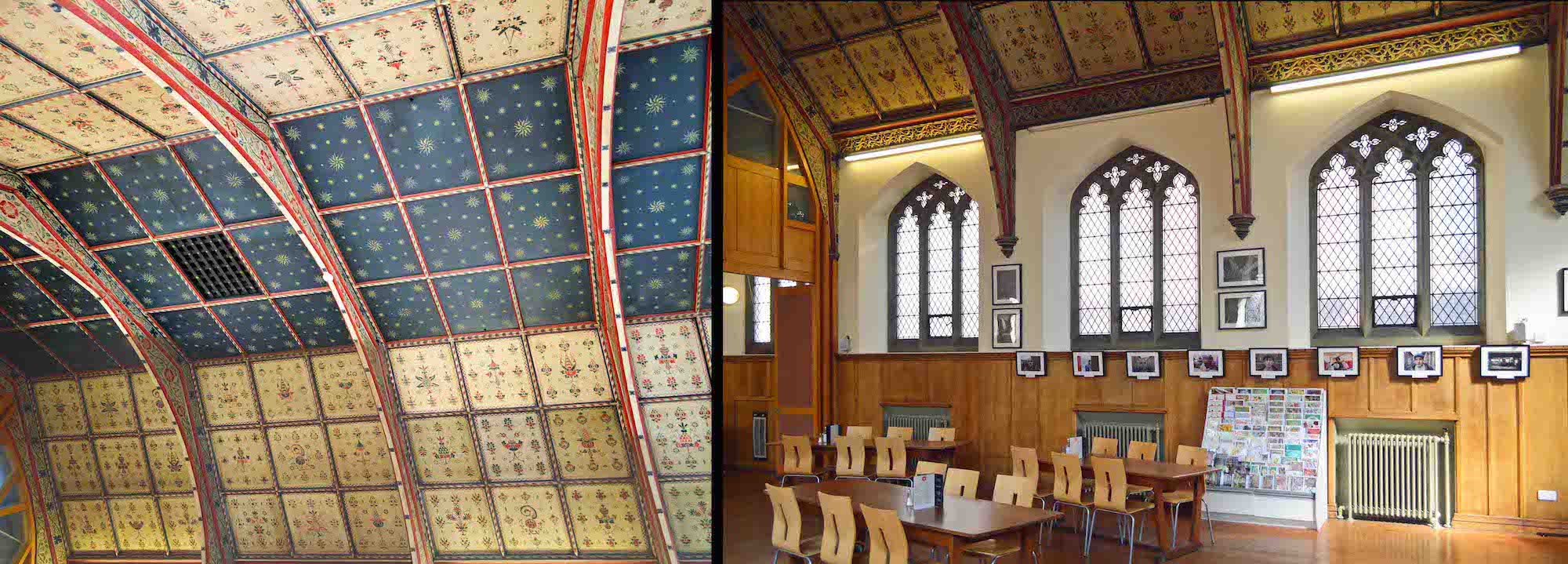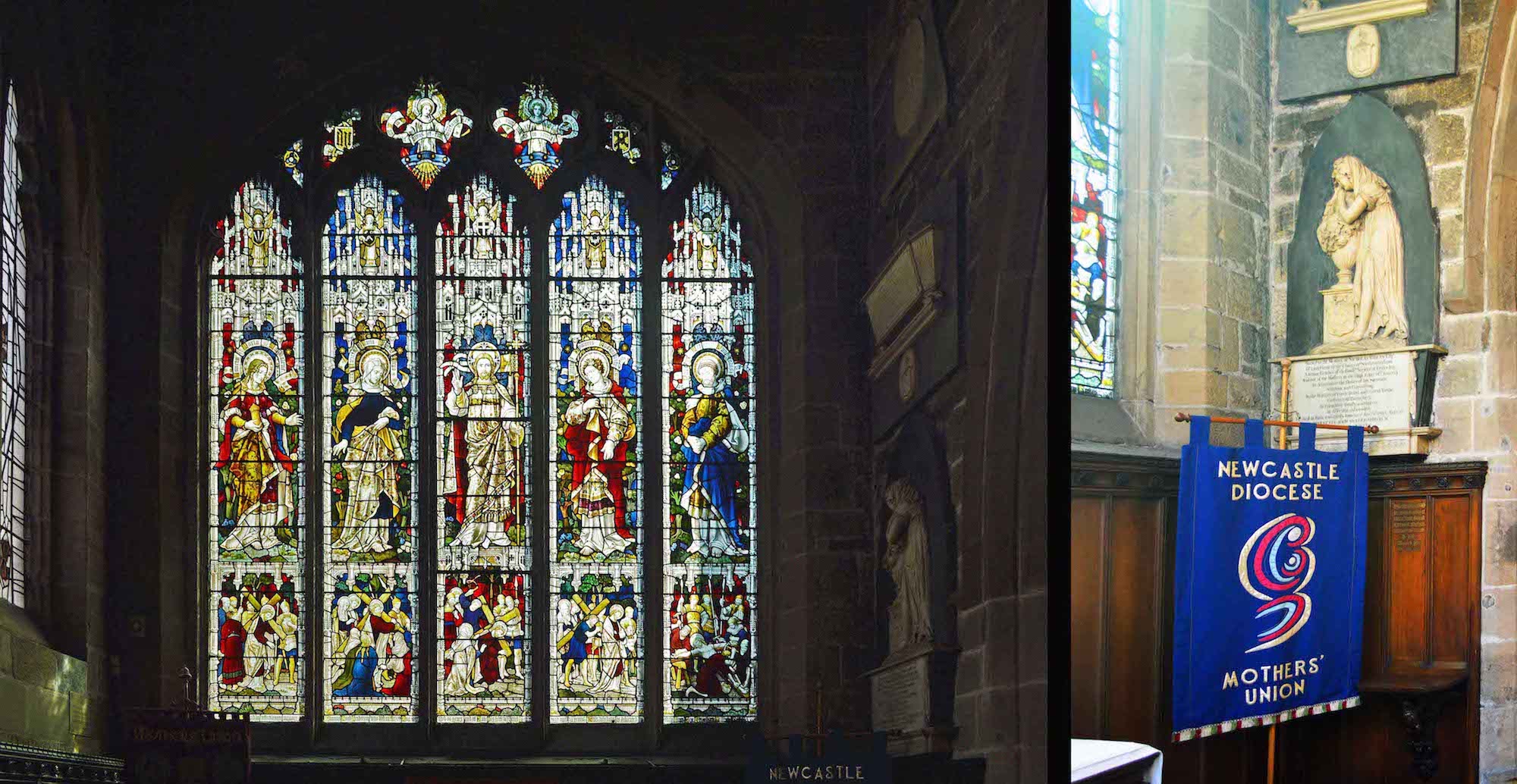
Our view is towards the large arch leading to the North choir aisle. Above the arch are two high stained glass windows. At right is a very fine carved alabaster lion which is part of the pulpit. To our left is the front of the organ, and beyond, in the corner, a wooden sculpture of St Nicholas. PLAN
62. CLERESTORY WINDOWS
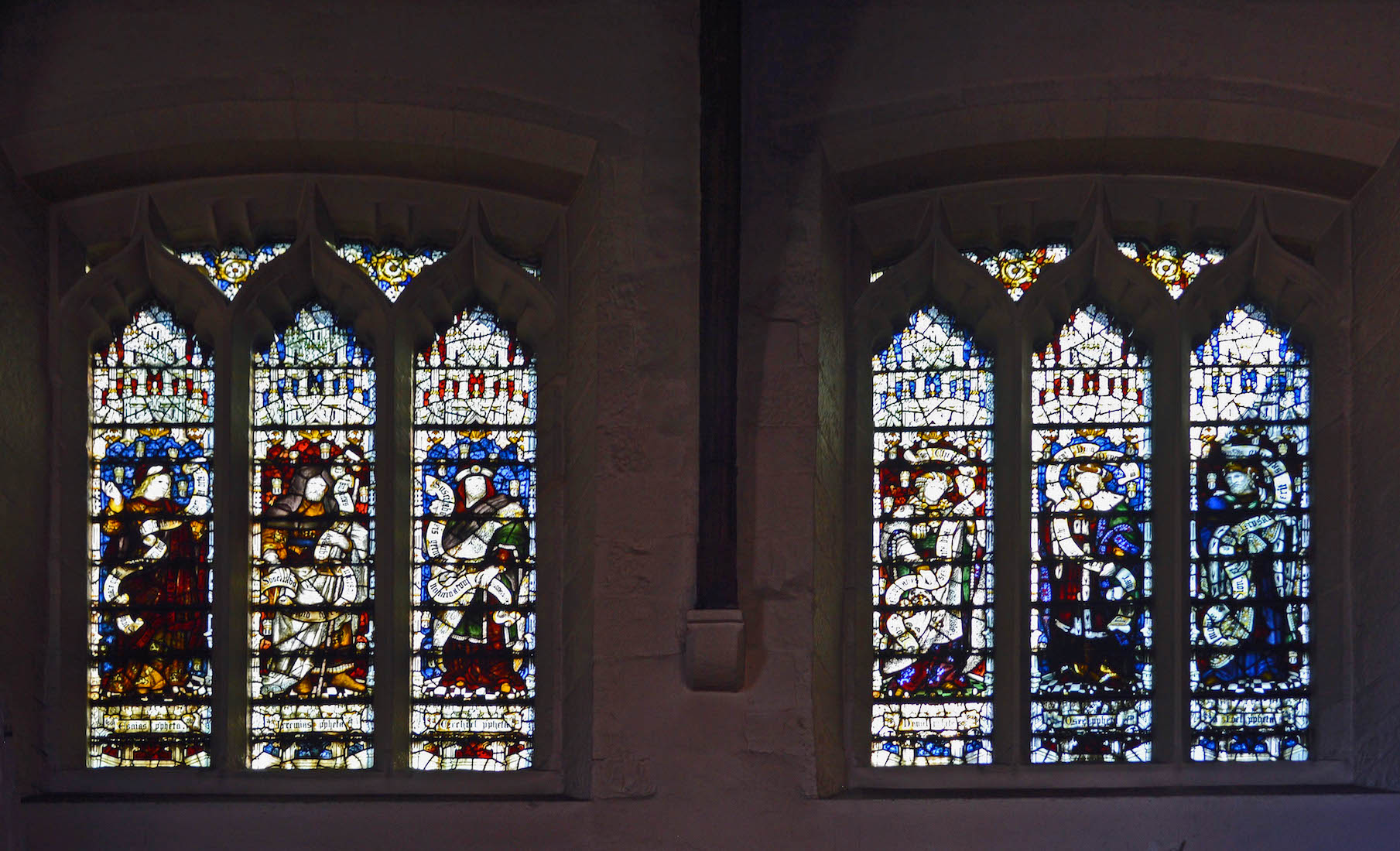
These high clerestory windows would probably be classified as North transept windows. Six Old Testament prophets are depicted, each carrying some text on a broad ribbon, and all rather indistinguishable. Fortunately they are labelled (from left): Isaiah, Jeremiah, Ezekiel; and Daniel, Hosea and Joel.
63. ORGAN DETAILS
The organ is delightfully decorated. Most obvious is the golden angel at top blowing a trumpet, and flanked by two reclining gold angels. Next is pictured two horns with a background of detailed foliage. And small cherubim and a line of foliage trace out the bottom of the organ pipes.
64. ST NICHOLAS
In the corner by the screen stands this carving of St Nicholas. Saint Nicholas (270 – 343) was a historic 4th-century Christian saint and Greek Bishop of Myra, in Asia Minor. Because of the many miracles attributed to his intercession, he is also known as Nikolaos the Wonderworker. His reputation evolved among the faithful, as was common for early Christian saints, and his legendary habit of secret gift-giving gave rise to the traditional model of Santa Claus through ‘Sinterklaas’.
65. ENTERING ST GEORGE’S CHAPEL
Walking through the archway we turn left into the 15th century St George’s chapel. The side of the organ is still visible on our left, and next to the pipes is another interesting memorial. This remembers William and Jane Hall. William was sometime mayor of Newcastle. At top is the family crest, and at bottom, it is supposed, a representation of their son and daughters. All very pious! Notice the crypt window below the memorial.
67. ALTAR AND GRAVE STONE
The text around the altar comes from Revelation 1:18 : I am he that liveth, and was dead; and, behold, I am alive for evermore. The letters ‘IC XC NIKA’ on the altar cloth stand for Jesus Christ Victorious. The gravestone is that of Matthew Prior.
68. CHAPEL NORTH WINDOWS
The six man panels of the North windows depict six saints – fortunately all identified. From left we have St Clement, St Nicholas (of course!), St Dunstan; St Columba, St Christopher (bearing theChrist child), and St Aidan. Dunstan was an Abbot of Glastonbury Abbey, a Bishop of Worcester, a Bishop of London, and an Archbishop of Canterbury, later canonised as a saint. His work restored monastic life in England and reformed the English Church. Two small upper panels in the window on right depict St Barbara and St Catherine.
69. WINDOWS AND MEMORIAL
These two windows and the memorial are on the East wall of St George’s chapel. The four saints depicted in the windows are from left: St Edmund (King and Martyr), St Edward (King and Confessor); St Oswald and St Cuthbert. There are many birds depicted in the right window. St Cuthbert was one of the most revered saints of early Christianity, and was the world's first nature conservationist. He introduced the world's first bird protection laws to protect the eider ducks and other sea birds nesting on the Farne islands. The monument at right remembers Thomas Surteis.
70. NORTH CHOIR AISLE
We leave St George’s chapel, and return to the North choir aisle. On our right is some high panelling with a list of Organists and Masters of the Music dating from as far back as 1508.
71. AISLE VIEW
As we continue along the North aisle, we are conscious of the rough-hewn feel of roof, floor, and outer walls. The arch at right would lead us through to the choir stalls and sanctuary. Beyond this appears to be an elaborate grave. Ahead is a lovely window, flag and banners. Not visible here are the windows in the wall at left.
72.NORTH CHOIR AISLE WINDOWS
The windows on our left are separated by various monuments. From left these remember: members of the Thomas Dawson family, Mayor Gilbert Buggin, and (illegible). The left window shows various scenes from the life of Jesus. The centre window depicts the Last Supper and two instances of foot washing – by Mary (of Bethany?), and Jesus himself. The right window shows Jesus in the Garden, and the betrayal by Judas Iscariot.
73. BISHOP LLOYD’S EFFIGY
This alabastar effigy of Bishop Lloyd was created by Frederick W. Pomeroy in 1908. Arthur Thomas Lloyd (1844-1907) was born in Berkshire, serving as Vicar of Aylesbury before coming to Newcastle, and becoming the first Vicar of Newcastle to become Provost of this Cathedral in 1882. He then served as a Suffragan (or assistant) Bishop in Norwich before returning to Newcastle in 1903 as its third Bishop. The Bishop’s mitre can be seen above the effigy's head in the right-hand corner of the monument. I like the angels at his feet!
74. SOUTH WALL OF THE AISLE
This is a navigational view. The North aisle ends in a downward set of steps just beyond the Bishop Lloyd effigy. On the wall just here are three prominent plaques.
75. THREE MEMORIALS
At left is a memorial remembering Edgar Jacob D.D. who was Bishop of Newcastle 1896 – 1903. The central framed brass remembers the First Bishop of Newcastle, Ernest Wilberforce, who served here from 1882 to 1896. He is described as a wise master builder. The memorial at right is in memory of the Fourth Bishop of Newcastle, Norman Dumenil John Straton D.D. who served from 1907 to 1915.
76. CAFÉ DOOR, DANISH MEMORIAL
During WWII, Newcastle became home to the Danish Merchant Fleet after the fall of Denmark in 1940. Over 4,000 Danish seamen sailed from the River Tyne (with over 1,400 losing their lives in the conflict). The Danish memorial at the East end is a beautiful slate piece which commemorates this history. At left is the door through to the Lantern Café in the old Cathedral hall – a welcome sight!
77. FINAL NORTH WINDOWS
The memorial at left may well be Danish. The 1907 window by Caroline Townsend next to it depicts various saints: St Finian, St Aidan/St Oswald, St Paul/St Edwin, St Cuthbert. Look for St Nicholas at the apex, and the two quatrefoils with St Oswald and the Venerable Bede. The central memorial is to John Atkinson. The adjacent window is the Danish Seamen's Memorial Window which was designed by Michael Davis in 2002. The Danish flag hangs close by. A similar window completes the set, but appears to be unrelated in its meaning.
78. LANTERN CAFÉ
The Lantern Café occupies the Cathedral hall. We remember that this was originally used as a library, and one feels that this space with its quietly restrained decoration might have been well-suited to this use. The windows are Gothic in structure, but with plain diagonal lattice squares. Various pictures hang on the walls.
79. ORNAMENTAL CEILING
But it is the highly decorative ceiling which draws the eye. The brightly coloured and patterned supporting arches hold up flat sections of 3 x 3 large painted tiles. The tiles in the central panels have stars and a dark background, and are all identical. The remaining tiles have festive designs on a cream background, and appear to be all different. The effect is enchanting.
80. THE RESURRECTION CHAPEL
We leave the Lantern Café and return to the corner of the Cathedral containing the Danish memorial. This area is called the Resurrection Chapel. On the Eastern wall is a large window with five lancets, depicting Christ and four saints: St Mary Magdalene, St Mary X Y, the Risen Christ, St John the Evangelist, St Peter the Apostle. To the right of the window stands the Mothers’ Union banner, and several memorials – in particular one for Nicholas Ridley.



